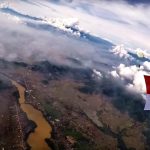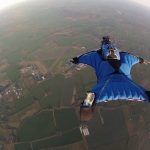Soaring Through the Skies: The Thrilling World of Wingsuit Flying
Description
Wingsuit flying, a breathtaking blend of human ingenuity and the primal urge to soar, has its roots in the early 20th century. The concept of gliding through the air with a suit designed to enhance lift can be traced back to the pioneering work of aviators and inventors. One of the earliest recorded instances of a wingsuit-like apparatus was in 1912 when French inventor Franz Reichelt attempted to fly from the Eiffel Tower using a parachute suit.
Although his endeavor ended tragically, it laid the groundwork for future innovations in aerial flight. The modern wingsuit, however, began to take shape in the late 1990s. The first functional wingsuits were developed by skydivers who sought to extend their freefall time and experience a more exhilarating descent.
Notable figures such as Patrick de Gayardon and Jari Kuosma played pivotal roles in refining wingsuit design, incorporating materials that allowed for greater maneuverability and control. By the early 2000s, wingsuit flying had gained popularity among extreme sports enthusiasts, leading to the establishment of dedicated wingsuit flying communities and events worldwide. The sport has since evolved, with advancements in technology and design allowing for increasingly sophisticated maneuvers and longer flights.
Key Takeaways
- Wingsuit flying has a history dating back to the early 20th century, with pioneers like Clem Sohn and Rex Finney making significant contributions to the sport.
- The physics of wingsuit flying involves understanding aerodynamics, lift, drag, and the body position required to achieve controlled flight.
- Equipment needed for wingsuit flying includes a wingsuit, parachute, helmet, altimeter, and other safety gear to ensure a safe and successful flight.
- Training and skills required for wingsuit flying involve extensive skydiving experience, physical fitness, mental focus, and the ability to make split-second decisions in the air.
- The dangers and risks of wingsuit flying are significant, with potential hazards including collisions, equipment malfunctions, and the need to navigate complex aerial environments.
- Personal stories and experiences of wingsuit flying enthusiasts highlight the intense thrill and adrenaline rush of flying through the air at high speeds, as well as the sense of freedom and accomplishment that comes with mastering this extreme sport.
The Physics of Wingsuit Flying
The Role of Lift and Drag
When a wingsuit pilot jumps from an aircraft, they enter freefall, during which gravity pulls them downward while the wingsuit’s fabric creates lift. The suit’s design features large surface areas that catch air, allowing the pilot to glide horizontally as they descend. This horizontal movement is crucial; it enables pilots to cover significant distances while falling, rather than plummeting straight down.
This refers to the angle between the wingsuit’s surface and the oncoming airflow. A higher angle of attack can increase lift but also leads to greater drag, which can slow down the pilot’s descent. Conversely, a lower angle of attack reduces drag but may decrease lift.
Optimizing Flight Performance
Skilled wingsuit pilots learn to balance these forces, adjusting their body position and wing configuration to optimize their flight path. Additionally, understanding how wind currents and thermals interact with their flight can significantly enhance a pilot’s ability to navigate through the air effectively.
The Equipment Needed for Wingsuit Flying

Wingsuit flying requires specialized equipment designed to ensure both performance and safety. The most critical piece of gear is, of course, the wingsuit itself. Modern wingsuits are crafted from lightweight, durable materials such as nylon or polyester, featuring a design that includes fabric wings extending from the arms and legs.
These wings are engineered to maximize lift while minimizing drag, allowing pilots to glide efficiently through the air. Various models cater to different skill levels and flying styles, from beginner suits with more stability to advanced designs that allow for intricate maneuvers. In addition to the wingsuit, pilots must also wear a parachute system tailored for wingsuit flying.
This typically includes a main parachute and a reserve parachute, both of which are packed into a specialized container that allows for quick deployment during flight. A crucial aspect of this system is the deployment mechanism; many wingsuit pilots use a “pull-out” system that allows them to deploy their parachute while still in freefall. Other essential equipment includes an altimeter to monitor altitude during descent, a helmet for head protection, and goggles to shield the eyes from wind and debris.
The Training and Skills Required for Wingsuit Flying
| Training and Skills Required for Wingsuit Flying | |
|---|---|
| Physical Fitness | Strength, flexibility, and cardiovascular endurance are essential for wingsuit flying. |
| Experience | Most wingsuit instructors require a minimum of 200 skydives before starting wingsuit training. |
| Wingsuit Training | Training programs typically include ground school, tunnel flying, and jumps with an instructor. |
| Canopy Skills | Proficiency in canopy control and landing techniques is crucial for safe wingsuit flying. |
| Risk Management | Understanding and managing the risks associated with wingsuit flying is a key skill for all practitioners. |
Training for wingsuit flying is a rigorous process that demands both physical fitness and mental acuity. Before donning a wingsuit, aspiring pilots must first become proficient skydivers. This typically involves completing a series of jumps with a standard parachute, mastering freefall techniques, and gaining experience in various skydiving conditions.
Most wingsuit schools require a minimum of 100 jumps before allowing students to transition into wingsuit training. This foundational experience is crucial; it equips pilots with the necessary skills to handle freefall dynamics and emergency situations. Once a skydiver has met the prerequisites, they can begin specialized wingsuit training.
This phase often includes ground school sessions where instructors cover essential topics such as aerodynamics, body positioning, and emergency procedures specific to wingsuit flying. Practical training involves supervised jumps where instructors provide real-time feedback on technique and performance. Pilots learn how to control their flight path by adjusting their body position and using their arms and legs effectively.
Mastery of these skills is vital; even minor errors in body positioning can lead to significant changes in flight dynamics.
The Dangers and Risks of Wingsuit Flying
While wingsuit flying offers unparalleled thrills, it is not without its dangers. The inherent risks stem from several factors, including altitude, speed, and environmental conditions. One of the most significant dangers is the potential for collision with terrain or obstacles during flight.
Wingsuit pilots often navigate through mountainous regions or canyons where even minor miscalculations can result in catastrophic outcomes. The need for precise control over one’s flight path cannot be overstated; a momentary lapse in focus can lead to disaster. Another critical risk involves parachute deployment.
Wingsuit pilots must deploy their parachutes at specific altitudes to ensure safe landings; deploying too late can result in insufficient altitude for a safe descent.
Weather conditions also play a significant role in safety; strong winds or poor visibility can complicate jumps and increase risks.
The Thrill of Wingsuit Flying: Personal Stories and Experiences

The thrill of wingsuit flying is often best conveyed through personal stories from those who have experienced it firsthand. For many pilots, the sensation of gliding through the air is akin to flying like a bird—an exhilarating freedom that few other activities can replicate. One seasoned wingsuit pilot recounted their first jump: “As I leaped from the plane, I felt an overwhelming rush of adrenaline mixed with sheer joy.
The world below me transformed into a breathtaking panorama as I soared through the sky.” Such experiences highlight not only the excitement but also the profound connection many feel with nature while flying. Another pilot shared their journey into wingsuit flying after years of traditional skydiving: “I was looking for something more—something that would push my limits further.” They described how mastering the intricacies of wingsuit flying became an obsession, leading them to explore remote locations around the globe for ideal jumping spots. Each jump brought new challenges and rewards; they spoke about navigating through narrow canyons or skimming over treetops at exhilarating speeds.
These personal narratives illustrate how wingsuit flying transcends mere sport; it becomes a lifestyle defined by adventure, camaraderie among fellow pilots, and an unquenchable thirst for exploration. The allure of wingsuit flying continues to captivate individuals from all walks of life, drawing them into a community bound by shared passion and respect for the sport’s inherent risks. As technology advances and more people discover this thrilling pursuit, the history of wingsuit flying will undoubtedly continue to evolve, inspiring future generations to take flight into the open skies.
FAQs
What is wingsuit flying?
Wingsuit flying is a skydiving discipline where participants wear a special jumpsuit that adds surface area to the human body, enabling a significant increase in lift. This allows the participant to glide through the air like a bird.
How does a wingsuit work?
A wingsuit works by creating additional surface area with fabric between the arms and body and between the legs. This increased surface area generates lift, allowing the wearer to glide through the air rather than simply free-falling.
What are the risks of wingsuit flying?
Wingsuit flying carries inherent risks due to the high speeds and proximity to the ground or other objects. Accidents can occur due to collisions, loss of control, or failure to deploy the parachute in time.
What training is required for wingsuit flying?
To participate in wingsuit flying, individuals must first become experienced skydivers and obtain a minimum number of skydives before undergoing specific wingsuit training. This training covers the use of the wingsuit, flight techniques, and emergency procedures.
Where can one go wingsuit flying?
Wingsuit flying can be done at various skydiving centers and drop zones around the world. However, it is important to ensure that the facility has the necessary infrastructure and safety measures in place for wingsuit flying.





